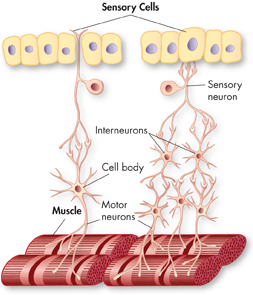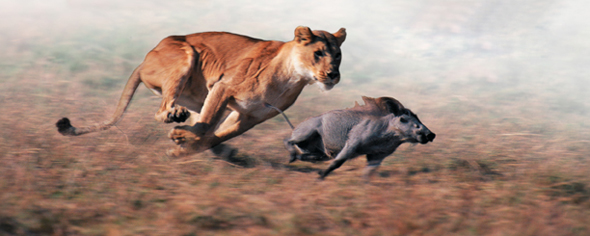Processing Information When sensory neurons detect a stimulus, they pass information about it to other nerve cells. Those neurons, which typically pass information to still other neurons, are called interneurons, as shown in Figure 28–1. Interneurons process information and determine how an animal responds to stimuli.
Does a particular odor mean food… or danger? Is the immediate environment too hot, too cold, or just right? The number of interneurons an animal has, and the ways those interneurons process information, determine how flexible and complex an animal's behavior can be.

FIGURE 28–1 Neural Circuits In some neural circuits, sensory neurons connect to motor neurons in ways that enable fast but simple responses (left). In others, specialized sensory cells connect to sensory neurons, which connect to interneurons, which connect to motor neurons (right). The more complex a circuit is, the more complex an animal's responses to stimuli can be.
dSome invertebrates, such as cnidarians and worms, have very few interneurons. These animals are capable of only simple responses to stimuli. They may swim toward light or toward a chemical stimulus that signals food. Vertebrates have more highly developed nervous systems with larger numbers of interneurons. The brain is made up of many of these interneurons. That's why the behaviors of vertebrates can be more complex than those of most invertebrates.
Responding A specific reaction to a stimulus is called a response. For example, waking up when you hear the alarm is a response.  When an animal responds to a stimulus, body systems—including the nervous system and the muscular system—work together to generate a response. Responses to many stimuli are directed by the nervous system. However, those responses are usually carried out by cells or tissues that are not nerve cells. A lion's decision to lunge at prey, as in Figure 28–2, is carried out by muscle cells that produce movement. In that case, nerve cells called motor neurons carry “directions” from interneurons to muscles. Other responses to environmental conditions may be carried out by other body systems, such as respiratory or circulatory systems.
When an animal responds to a stimulus, body systems—including the nervous system and the muscular system—work together to generate a response. Responses to many stimuli are directed by the nervous system. However, those responses are usually carried out by cells or tissues that are not nerve cells. A lion's decision to lunge at prey, as in Figure 28–2, is carried out by muscle cells that produce movement. In that case, nerve cells called motor neurons carry “directions” from interneurons to muscles. Other responses to environmental conditions may be carried out by other body systems, such as respiratory or circulatory systems.

FIGURE 28–2 Response Mammals, like the lion and wart hog shown here, have complex sensory organs and many interneurons. These animals can therefore process and respond to information in complex ways. Lions stalk and pursue their prey, and wart hogs try to evade their attackers.
Table of Contents
- Formulas and Equations
- Applying Formulas and Equations
- Mean, Median, and Mode
- Estimation
- Using Measurements in Calculations
- Effects of Measurement Errors
- Accuracy
- Precision
- Comparing Accuracy and Precision
- Significant Figures
- Calculating With Significant Figures
- Scientific Notation
- Calculating With Scientific Notation
- Dimensional Analysis
- Applying Dimensional Analysis




